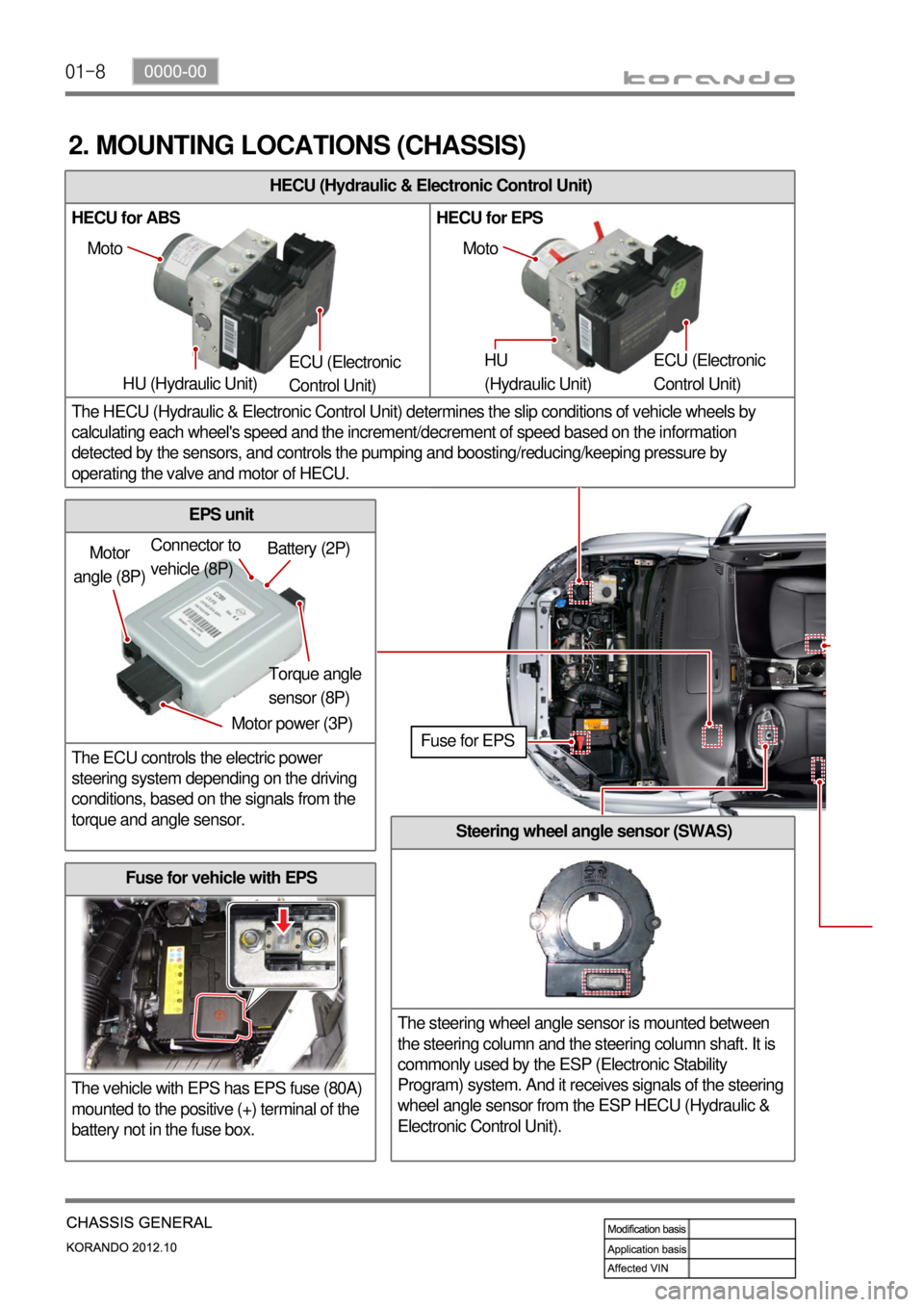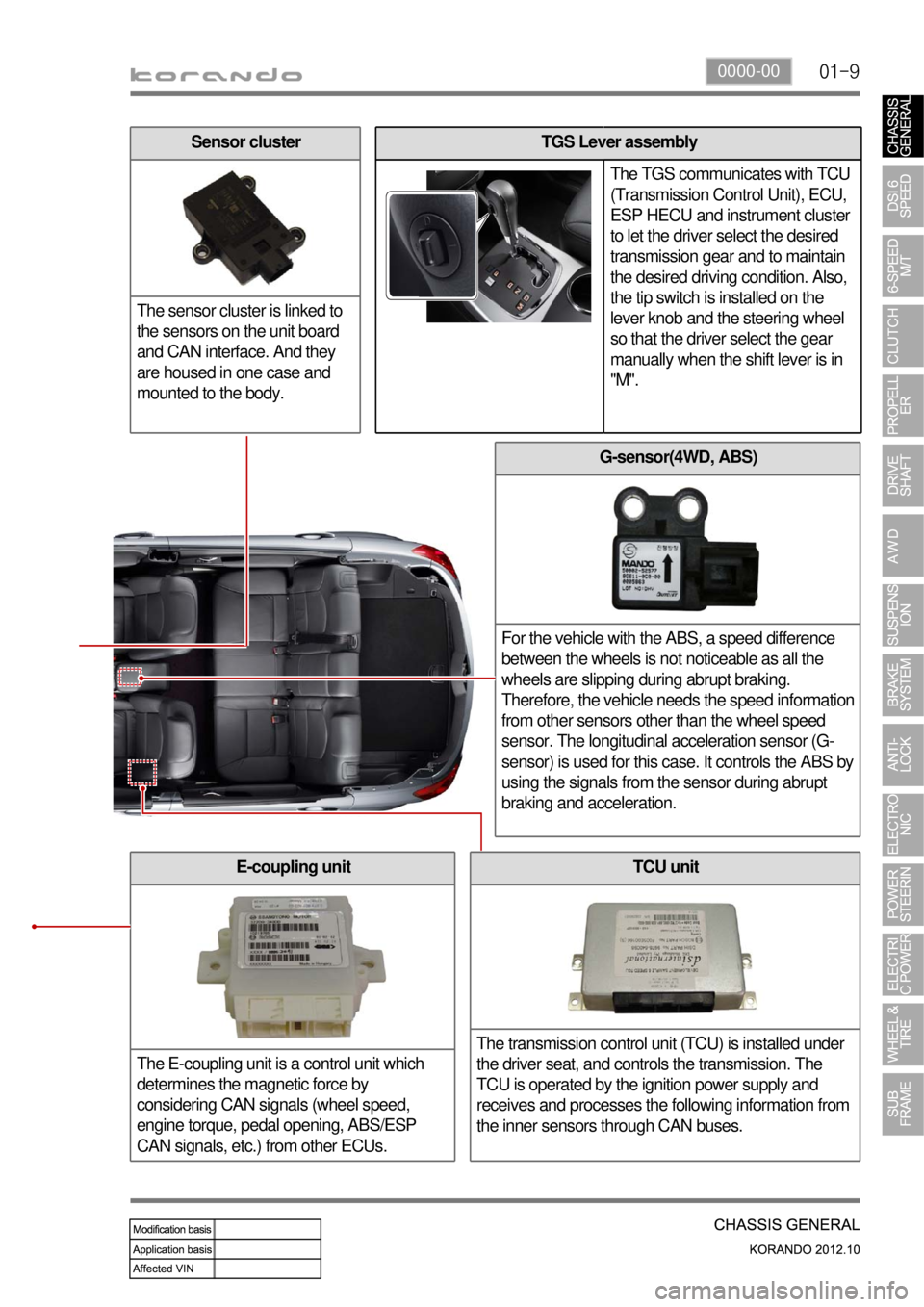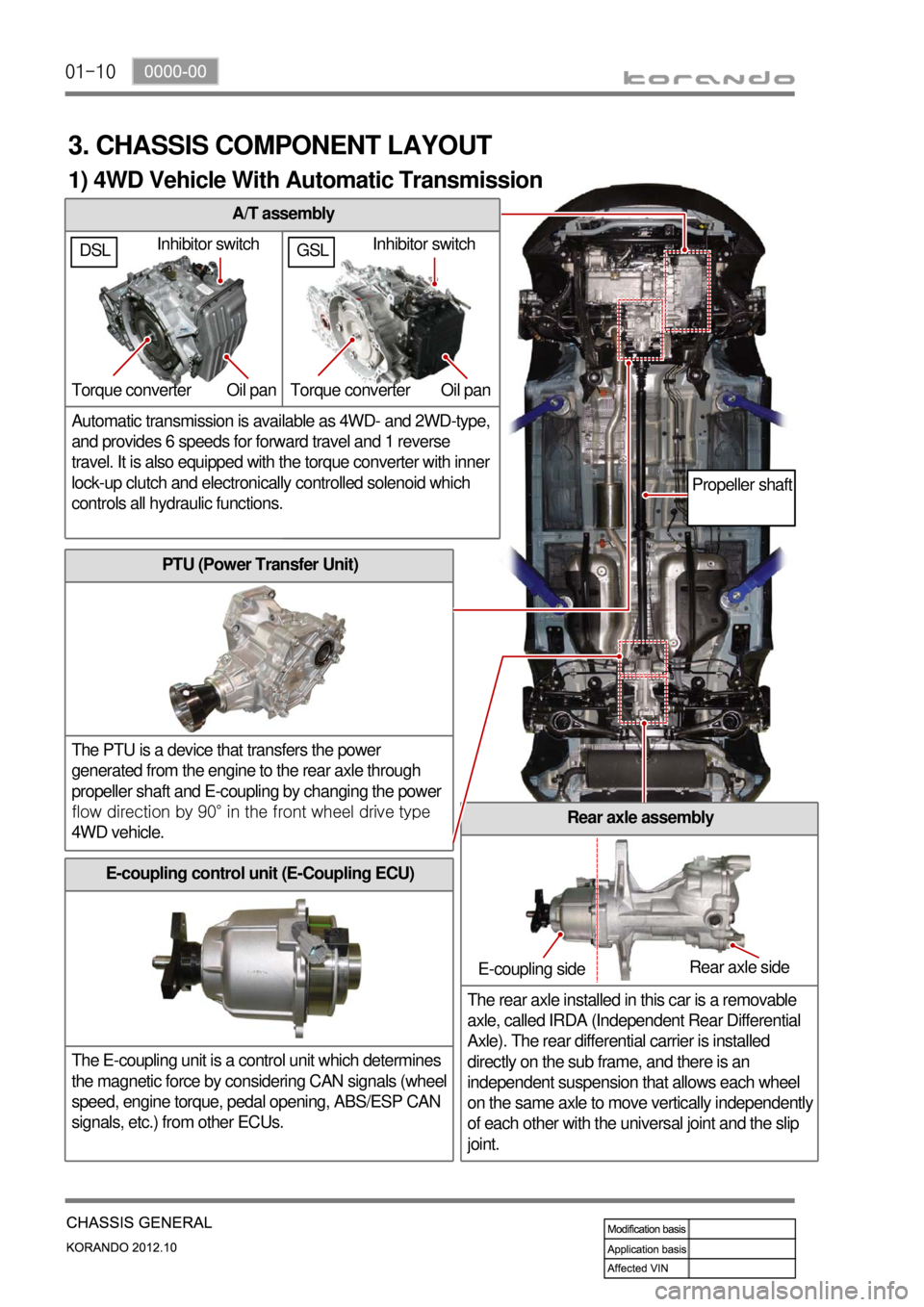ABS SSANGYONG KORANDO 2012 Owner's Manual
[x] Cancel search | Manufacturer: SSANGYONG, Model Year: 2012, Model line: KORANDO, Model: SSANGYONG KORANDO 2012Pages: 1082, PDF Size: 96.1 MB
Page 795 of 1082

09-38790-00
1. SPECIFICATION
Pin No. Specification Pin No. Specification
Rated voltage
DC 12.0 VInsulating resistance No heat & fire due to current
leak
Operating voltage
DC 9.0 V ~ 16.0 V
Max. permissible
currentUnit: 100 mA or less
Operating
temperature-30℃ ~ +80℃
Sensor: 20 mA or less
Storage temperature
-40℃ ~ +85℃
WeightUnit: 75.7 g±5 g
Maximum humidity
95%Sensor: 38.7 g±5 g
2. CAUTIONS
Sensor Cannot Detect ▶
When the sensor is frozen (operate normally when it's thawed)
When the sensor is covered with foreign materials such as snow or condensation
(if the foreign materials are removed, the sensor operates normally.) -
-
Not defective but improperly working ▶
When the sensing portion is frozen (operates normally after thawed)
When reversing on rough roads, gravel roads, hills, or grass.
When receiving other ultrasonic signals (metal sounds or air braking noises from heavy
commercial vehicles).
When there is heavy rainfall or water drops.
When the sensor is covered with snow. -
-
-
-
-
Certain obstacles that sensors cannot detect ▶
Thin and narrow objects, such as wires, ropes, or chains
Cotton, sponge, clothes, snow that absorb ultrasonic waves. -
-
Weak Sensing Scopes ▶
When the ambient temperature is too high or too low.
When a 1 m or less long small object with a diagmeter of 100 mm or less is detected. -
-
Page 818 of 1082

01-8
Fuse for vehicle with EPS
The vehicle with EPS has EPS fuse (80A)
mounted to the positive (+) terminal of the
battery not in the fuse box.
EPS unit
The ECU controls the electric power
steering system depending on the driving
conditions, based on the signals from the
torque and angle sensor.
HECU (Hydraulic & Electronic Control Unit)
HECU for ABS HECU for EPS
The HECU (Hydraulic & Electronic Control Unit) determines the slip conditions of vehicle wheels by
calculating each wheel's speed and the increment/decrement of speed based on the information
detected by the sensors, and controls the pumping and boosting/reducing/keeping pressure by
operating the valve and motor of HECU.
2. MOUNTING LOCATIONS (CHASSIS)
Moto
HU (Hydraulic Unit) ECU (Electronic
Control Unit) Moto
HU
(Hydraulic Unit) ECU (Electronic
Control Unit)
Motor
angle (8P)
Motor power (3P)Torque angle
sensor (8P) Battery (2P) Connector to
vehicle (8P)
Fuse for EPS
Steering wheel angle sensor (SWAS)
The steering wheel angle sensor is mounted between
the steering column and the steering column shaft. It is
commonly used by the ESP (Electronic Stability
Program) system. And it receives signals of the steering
wheel angle sensor from the ESP HECU (Hydraulic &
Electronic Control Unit).
Page 819 of 1082

01-90000-00
G-sensor(4WD, ABS)
For the vehicle with the ABS, a speed difference
between the wheels is not noticeable as all the
wheels are slipping during abrupt braking.
Therefore, the vehicle needs the speed information
from other sensors other than the wheel speed
sensor. The longitudinal acceleration sensor (G-
sensor) is used for this case. It controls the ABS by
using the signals from the sensor during abrupt
braking and acceleration.
TCU unit
The transmission control unit (TCU) is installed under
the driver seat, and controls the transmission. The
TCU is operated by the ignition power supply and
receives and processes the following information from
the inner sensors through CAN buses.E-coupling unit
The E-coupling unit is a control unit which
determines the magnetic force by
considering CAN signals (wheel speed,
engine torque, pedal opening, ABS/ESP
CAN signals, etc.) from other ECUs.
TGS Lever assembly
The TGS communicates with TCU
(Transmission Control Unit), ECU,
ESP HECU and instrument cluster
to let the driver select the desired
transmission gear and to maintain
the desired driving condition. Also,
the tip switch is installed on the
lever knob and the steering wheel
so that the driver select the gear
manually when the shift lever is in
"M".Sensor cluster
The sensor cluster is linked to
the sensors on the unit board
and CAN interface. And they
are housed in one case and
mounted to the body.
Page 820 of 1082

01-10
A/T assembly
Automatic transmission is available as 4WD- and 2WD-type,
and provides 6 speeds for forward travel and 1 reverse
travel. It is also equipped with the torque converter with inner
lock-up clutch and electronically controlled solenoid which
controls all hydraulic functions.
3. CHASSIS COMPONENT LAYOUT
PTU (Power Transfer Unit)
The PTU is a device that transfers the power
generated from the engine to the rear axle through
propeller shaft and E-coupling by changing the power
<008d00930096009e0047008b00900099008c008a009b0090009600950047008900a000470060005700b60047009000950047009b008f008c0047008d009900960095009b0047009e008f008c008c00930047008b00990090009d008c0047009b00a0009700
8c0047>
4WD vehicle.
Rear axle assembly
The rear axle installed in this car is a removable
axle, called IRDA (Independent Rear Differential
Axle). The rear differential carrier is installed
directly on the sub frame, and there is an
independent suspension that allows each wheel
on the same axle to move vertically independentl
y
of each other with the universal joint and the slip
joint.
E-coupling control unit (E-Coupling ECU)
The E-coupling unit is a control unit which determines
the magnetic force by considering CAN signals (wheel
speed, engine torque, pedal opening, ABS/ESP CAN
signals, etc.) from other ECUs.
Inhibitor switch
Torque converter Oil pan
E-coupling sideRear axle side
Propeller shaft
1) 4WD Vehicle With Automatic Transmission
GSLDSLInhibitor switch
Torque converter Oil pan
Page 824 of 1082

01-14
Stabilizer bar assembly
The stabilizer bar assembly is not activated if the left/right
wheels move up/down simultaneously, but if both wheels
move up/down differently it is activated with frame to
minimize the tilting of the body.
5. FRONT SUSPENSION COMPONENT LAYOUT
Front suspension supports the vehicle weight and absorber the vibration from tires. And, in this type of
suspension, the steering linkage tie rod is mounted on the knuckle. The Macpherson Strut suspension
is an independent suspension which has a spring on the strut with a built-in shock absorber. The lower
arm is installed on sub frame and large strut damper is installed on the knuckle to support the tire.
Lower arm assembly
The lower arm assembly connects the frame and
knuckle. It supports the load transferred to the tire
knuckle, relieves the impact from the vehicle and ground
conditions, and ensures driving stability.
Stabilizer bar
Bushing
Clamp
Link
Page 825 of 1082

01-150000-00
Front coil spring assembly
The coil spring is made by winding solid steel rod to form
the coil shape. Its energy absorption rate per weight is
higher than that of the leaf spring and it allows to absorb
small vibration properly resulted in keeping the ride
comforts. Therefore, it's difficult to make an effect on
vibration damping because there is not any friction
between coils.
Coil spring
Shock absorber assembly
Page 826 of 1082

01-16
6. REAR SUSPENSION COMPONENT LAYOUT
Multi-link type suspension is the independent suspension. It provides good ride comfort and drivability
by reducing the coil spring weight. Also, it increases the space for passenger compartment by lowering
the floor.
This type of suspension consists of multiple links such as trailing arm, upper arm, lower arm and track
rod.
Shock absorber assembly
This vehicle uses the gas
shock absorber. This
relieves the vertical
vibrations of vehicle to
provide ride comforts,
prevents the spring break,
enhances drivability, and
extends the life span of
steering components.
Upper arm assembly
Upper arm is installed between knuckle and sub
frame and controls the lateral load and vehicle
height.
Trailing arm assembly
Trailing arm is installed between knuckle and
vehicle body and controls the front and rear load.
Track rod assembly
Track rod is installed between knuckle and rear
sub frame and controls and compensates the
lateral load.
Page 828 of 1082

01-18
A. Indicators on instrument cluster
C. HECU assembly
The HECU assemblies for ABS and ESP have
similar appearance but they have different inner
structure and connector connections from each
other. D. Front brake assembly
The disc brake for 4WD vehicle is the same with
the one for 2WD vehicle.
7. BRAKE SYSTEM AND ESP SYSTEM LAYOUT
B. Master cylinder assembly
Description for master cylinder in this chapter is
based on ABS/ESP equipped vehicle. For CBS,
there is an extra pressure valve mounted to the
master cylinder.
CaliperDisc
Parking brake
warning light
ABS warning lamp
ESP indicator
Page 830 of 1082

01-20
Steering gear box assembly
The steering gear box assembly consists of power cylinder and control valve. The power cylinder has a
cylinder, piston and piston rod. The control valve directs the oil to one end face of the piston to enhance
the steering force. There is a safety check valve which lets the driver steer manually when there is a
malfunction in the hydraulic circuit.
8. STEERING SYSTEM LAYOUT
1) HPS (Hydraulic Power Steering)
The hydraulic pump is a vane
type pump and consists of the
flow control valve and pressure
relief valve.The oil reservoir sends the oil to
the power steering pump and
receives the oil from the power
steering gear.There is a shock absorber which
is folded in the axial direction
when the vehicle is crashed and
a ignition switch assembly on
the column shaft.
The lower shaft minimizes the
torque change using a CV joint
which has constant angular
speed.
Tie rod endSteering cylinderGear box
Tie rod end
Hydraulic pipeColumn shaft
Lower shaft
Steering wheel
assembly
Hydraulic pipe & hose
Page 907 of 1082

05-4
1. OVERVIEW
The propeller shaft is a thin steel pipe which transfers the power from the transmission to the E-coupling,
and has high resistance to torsion and bending.
The propeller shaft has the universal joint (cross axle) mounted on the center of the shaft and splines for
the slip joint on the E-coupling side to accommodate the height and length changes which occur as the
shaft rotates at high speed.
And the rubber bushing for center bearing in the center of the propeller shaft keeps the balance of the
shaft and absorbs its vibration.
Function of propeller shaft ▶
Transmits driving torque.
Accommodates the angle change (universal joint / CV joint).
Accommodates the axial length change (splines for the slip joint). -
-
-
CV joint
Universal yoke and
center bearingUniversal yoke and
rubber coupling